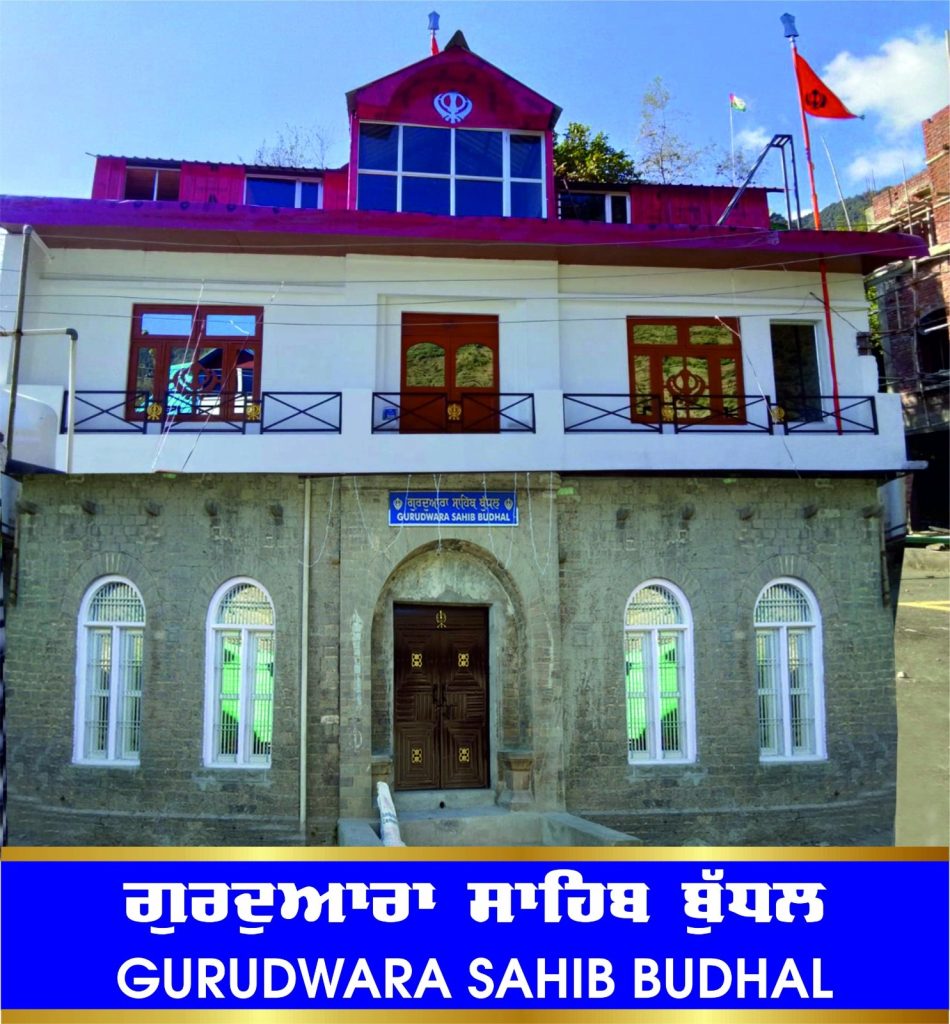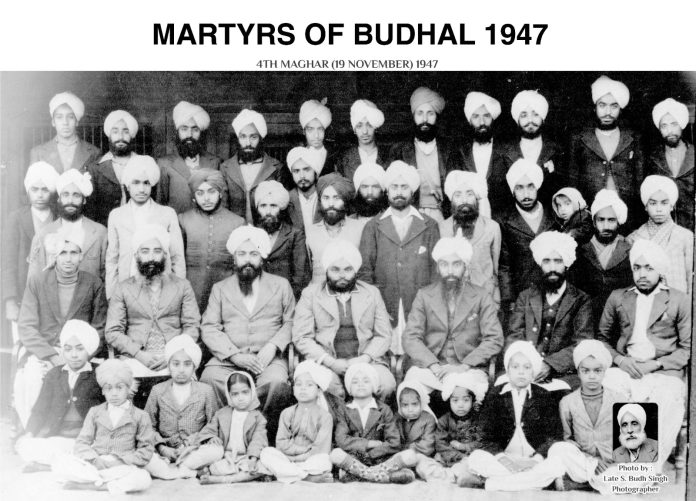Dr Nater Singh
There are many things worth living for, a few things worth doing for and nothing worth killing for. On the eve of partition of the country (1947) and under the fast developing political conditions, people almost everywhere witnessed a large number of incidents of atrocity and cruelty metaphorically calling these as’Death Dance’. In reference to dreadful event, popularly known as Budhal Massacre’ (19th November 1947) the level of brutality done by raiders sponsored by Pakistan had stunned the entire community at large and members of Sikh community in particular.Needless to say that a large number of persons had assembled inside the then existing historical Gurdwara Sahib to participate in a routine congregation. Though the disciples present fought bravely but as gun shots and petrol bombs were frequently used by attackers,it resulted in intense smoke and fire flames. Due to this act of savagery and ghastliness, dozens of persons including men, women, children and elders alike were killed. Few survivors managed to come out through a side window. Thereafter, with the help of a wooden plank they crossed over to the veranda of a nearby mosque and assembled in its lawn below. But when one of them resorted to honour killing of their women, the Sikhs retaliated and refused to talk with attackers. As the attackers’ mood became violent, the Sikh families preferred death by talking poison and getting milled by themselves. The pre- 1947 structure of Gurdwara Sahib Building (built around 1910 AD) was severely damaged due to this carnage which was a well plannedmanoeuvering backed by a process of newly created Pakistan.
 Almost 77 years have rolled on when such an instance of brutality and barbarity took place on innocent unarmed persons which cannot be erased for centuries together. These shockingly atrocious acts of outrageous cruelty were witnessed almost in all parts of erstwhile J&K State including places like Rajouri, Thannamandi and Budhal.
Almost 77 years have rolled on when such an instance of brutality and barbarity took place on innocent unarmed persons which cannot be erased for centuries together. These shockingly atrocious acts of outrageous cruelty were witnessed almost in all parts of erstwhile J&K State including places like Rajouri, Thannamandi and Budhal.
It is not inappropriate to quote a Verse enshrined in Sri Guru Granth Sahib Ji at (page) Ang 360, which reads as:
‘Je saktaasaktekau mare taa man rosnahoiee’
Meaning thereby, if some powerful man strikes out against another powerful man, then no one feels any grief in their mind
Dr. Ramesh Tamiri in his book ‘Pakistan’s Invasion on J&K (1947 – 48)’ writes that there were only three survivors among the Sikhs in Budhal namely Jaswant Singh 4 years old, Randheer Singh 12 years old and Mohinder Singh 11 years old. Jaswant Singh’s parents, two brothers, one sister married in Budhal and unclePartap Singh, all died in the carnage. Mohinder Singh succeeded in reaching to his relatives place at Khwas taking the Mogra-Bamla route.
Indeed, lucky are those who survived such a holocaust. Often such incidents of massacre in a particular family, lead to depression, despair, and even death to other members. Initially both Randheer Singh and Jaswant Singh were protected by a Muslim named Saddiq who lived in Kundardaan. He successfully pleaded attackers to spare the lives of those two boys. Another person of the said village named Haji Mohd. Khan brought such boys to his own house feeling it to be more safe. Having heard the presence of two Sikh boys in his house, attackers reached there to locate them. Haji Mohd. Khan (a pious person) opened his shirt and told attackers “first kill me before you kill them” as has been quoted by Dr. Ramesh Tamiri.
The two Sikh boys were then shifted to a nearby Panji Ki Maal Camp. Having heard about the shifting of said two boys to the camp, another Muslim popularly known as Tailor Shamasuddin reached there and told attackers that these boys could stay at his house. Despite risky location of his house, he managed to save them. It is well said ‘Relationship never die a natural death. They are always murdered by ego, attitude and ignorance.’ When Indian forces launched operation to liberate Budhal, many local Muslims fled to Pakistan. Shamasuddin also fled and carried those Sikh boys along.
Climbing Gabbar hills, they stretched a long distance up to Plandri via Rawalakote. Their next station was Wah camp located in the district of Rawalpindi. Getting an information from Gian Singh and Nanak Singh, police took those boys to Police Station. After sometime Tailor Shamasuddin also reached there and told policeman that the boys did not known about the existing situation but they do have relations in Jammu. Shamasuddin had also brought bIankets and some eatables for them. A little later his family members also reached there to see them. Finally, the boys were taken in a police vehicle to Lahore and lodged in a camp existing inside Budi Central Jail. Here two elderly Hindu women from village SikriSawari also met them and encouraged these boys. At last after a month and a half, both Jaswant Singh and Randheer Singh were repatriated. They were brought from Amritsar to Yol Camp from where their relatives took them to Jammu.
Reaching Jammu these boys were initially admitted in Home (orphanage) Centre existing in TalabTillo area. A similar centre was also available in Srinagar City. All orphans including those 2 Sikh boys were made to shift their homes during winter and summer season respectively. After sometime, both of them, who were closeIy related, went to Budhal. As the time passed, Randheer Singh started his business there with little available resources and Jaswant
Singh came into contact with a known photographer S. Budh Singh. As both worked together, Jaswant Singh learned the art of photography rather excelled in this field. Once he had three shops of photography at Nowshera, Rajouri and Jammu. Dr.RameshTamiri writes “A Family from Lalamusa, Punjab, comprising of three brothers Ganga Singh, Johd Singh and Budh Singh was staying at Budhal. All members of this family were killed in the attack. Since Budh Singh was in Rajouri, he fled to Jammu and survived.”
The idea to reconstruct the Gurdwara building came into the mind of SardarJaswant Singh (a sole survivor), who is living and residing at present in Trikuta Nagar, Jammu. It is not inappropriate to mention the name of SardarSarishti Singh who remained instrumental in supervising and executing the said construction work from start to finish. Although the earlier life of SardarJaswant Singh was full of sufferings and turmoil, yet in subsequent old years, he aspired to do something for someone and something to hope for. Perhaps his motive is to keep the lamp of spiritualism alive and make people realize that happiness is neither within us, nor without us, it is a union of ourselves with God. Indeed, such person are gardeners who make our souls blossom. Pertinent to mention that a new two story building for Gurdwara Sahib has recently been completed to memorize the sacrifice of hundreds of unarmed innocent persons.
It may be mentioned that a tribute is not only for the deceased, it is also for the living, for those who manage to give contribution or service, doing remarkable things and still inspire and influence others.
Concludingly, it may be stated that the seize of Budhal sustained for some time till the area was cleared of raiders by Indian forces. Since the entire episode was very painful, every Indian will feel indebted and remember the martyrs with moist eyes for a very long time. Although all objects living or lifeless are subservient to time, yet it is the time again which has given a new lease of life to Budhal and its inhabitants. Budhal is now a legislative constituency (ST) and has a status of Niabat of Kotranka tehsil. The necessary facilities in the fields of education, health, security, agriculture etc. have been made available to the local populance. Despite Budhal being a pre-dominant Muslim community, the spirit of fellow feeling and hospitality are the chief characteristics of local persons. Although Gojri and Paharhi are local languages yet at times they use Urdu, Dogri and Punjabi while conversing particularly with visitors. Pertinent to mention that this town falls on the southern range of PirPanchal and is connected with motorable road with Rajouri, GulGulabgarh and Reasi, the area is rich in beauty having snowy peaks, forests, dhokes-pastures, meadows, lakes, rivers etc. but lacks developments from the tourism point of view. It is high time that the Government undertakes much more development projects which may provide a healing touch and solace to the wounds inflicted on this town and its people on 19thNovember 1947.
(The author is former Principal)


